VILLARD, Giornale
dell'università IUAV: 39
“TOURISM city, coast, mountain, extraurban, territory, island
Pictures from Rome
“tourist diseducation” of the identity of Rome
by Mattia Darò
Can we consider the tourism a realized utopia of the third millennium?
An utopia in which the practices of nomadism, spiritualism, situationism,
and of all the XX century vanguard movements, flow together getting
more and more organized? Are the tourists the "day-trippers”
mentioned by Guy Debord, Gilles Ivain and Constant on their writings
?
We can define the tourism as a conceptual process that starts from
the “head”, and we can say that it consists in a physical
movement to “other beaches” after the idealization of
these. The aspect of making "the right choice" is very strong
and crucial in evaluating the result of the tourist experience (the
choice of the places to visit, the places where to eat and where to
sleep, even if the manner is camping and auto cooking). This was about
the tourism experience, that everybody already had. But what about
the design of the tourist offer? As said in the editorial, mentioning
Stefano Boeri, the tourism has redefined an atlas where the new geography
aims at re-establish logic agreements between things of the space,
the words that we use to nominate them and the mental images that
we project on them. But how is it possible to redefine this atlas?
How many and which are the choices that we have to do in order to
define a projectual strategy?
This short text is a commentary on 4 couples of images that correspond
to 4 moments of the city of Rome, all crucial for the process of building
a new identity of the city which is today being questioned by the
tourism phenomena. The 4 couples of images are meant to be icons of
a tourism typology. As well as some “postcards”, these
four episodes would indicate an imaginary that has been exported in
the whole world. The city of today is still feeding this imaginary,
and at the same time the imaginary is being fed by the tourism phenomenon.
The title of the article refers to the capacity of tourism to act
as a “non-educational” phenomenon for the identity, but
it has to be related not to the visitor (he always learns something
from a trip, whatever is the way he does it), but to the city, which
is altering its own identity to allow and make easier the tourist
activities. That situation brings the city into a continuous whirl
“diabolically consumer” of a “creative regeneration”,
that aims at feeding new fluxes and new tourism.
The paintings/postcards of Panini, or romantic tourism
Giovanni Paolo Panini has interpreted the profession of painter as
a real merchant of images, absolutely realistic but also absolutely
fantastic, marking a difference from the attitude of other so-called
“vedutisti” like him, such as Piranesi.
Creating his his "paintings-manifesto" Panini builds some
“urban iconographies” that are at the same time collage-compositions
and tourist spots. His activity is not just the translation of the
architectures of Rome into images, he invents a classification of
the more important sights, building what today is the daily mythography
that produces the postcards.
A good example of his attitude is found in the painting I capricci
di rovine where Panini seem to get fun by building analogous scenes
where pieces of the city mix together in a free and fantastic composition.
In the capricci the Marco Aurelio statue lives with the Pantheon and
with the Antonina column, proposing a sort of photoshop© reclame-image
of Rome and its beauties.
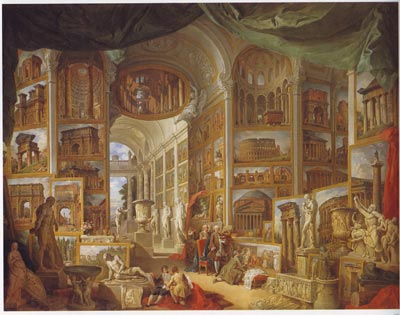 |
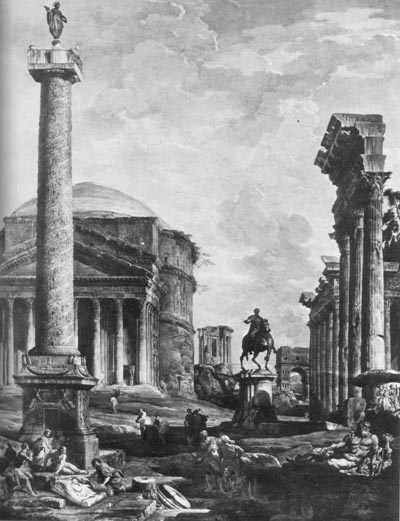 |
Giovanni Paolo Panini, Picture gallery with views of ancient Rome,
1757
Giovanni Paolo Panini, Capriccio di rovine
David between Villa Medici and the Bastille, or ethic tourism
The Jean-Jacques David journey in Villa Medici has left a mark on
the city because Rome has been selected as the ambience of its paintings.
In opposition to Panini, David doesn’t choose Rome for its architectural
beauties but more to develop ethic contents, that he identifies with
the classic era. In this way David helps to build a modern identity
of Rome in a form more significative. In his work the city appears
not through the simple reproduction of the urban ambiences, but through
the tracks of its history. David restores the milieus that describe
the ideals. Oath of the Orazi for example is strongly characterized
by a succession of messages that are directly referred to what it’s
happening in France at that time, with the revolution (the sacrifice
for the fatherland, the delivery of the power from the father to the
sons). David builds a perfect metaphor, keeping together political
contents, cultural movements and a new artistic technique. And Rome
is then the ideal scenery to speak about the problems of the fundamental
choices of the humanity.
 |
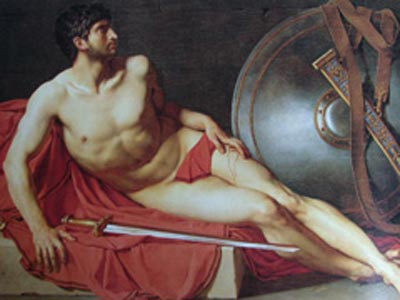 |
Jean Jacques David, Oath of the Orazi, 1784, Louvre Museum, Paris
Jean-Germain Drouais, The athlete (or gladiator) dying, 1785
La dolce vita,
or the mass tourism
The movie of Federico Fellini “la dolce vita” is a moment
for the process of building-up the “exportable image”
of Rome. “La dolce vita” represents an incredible vehicle
to feed the myth of the capital. The charm of the “eternal city”
doesn’t refer only to the building of the neoclassic identity
or to the representation of “eternal” values that the
history hands on.
It’s born the “tourist park”, the city of the Americans,
the city that opens to the mass consumption and to the tourism power.
It’s the birth of the “tourist park”, the city of
the Americans, the city that opens itself to the mass consumption
and to the tourism power. Everything is good: the holy and the profane
are mixed together into an amoral orgy of meta-representations of
the city itself. And the movie of Fellini is incredibly sensitive
to register everything. Thought as a sequence of scenes, Fellini films
“archetype images” more than histories. Many scenes of
the movie still today could be used as a synthesis of the image of
Rome. The Anita Ekberg icon, that bathes on the water of the fountain,
today attracts much more tourists than the fountain itself as monument.
And the invasion of the American culture represents the invasion of
a consumer system where the cities and the landscapes lose their historical-cultural
value to acquire a new value, totally based on the media representation.
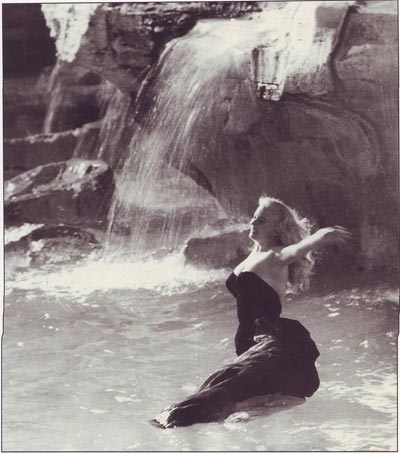 |
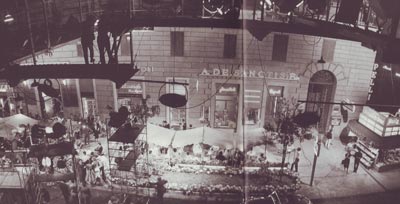 |
Set photo of the scene on the Fontana di Trevi, from Federico Fellini
“La dolce vita”1960 Set photo of via Veneto (reconstruction
in studio), from Federico Fellini “La dolce vita”, 1960
Tourist delirious, or today.
The three moments, just described, have marked (in a premonitory way,
as always happens with the artist activities) the tourist destiny
of Rome. The identity, as we usually consider it, is disappearing,
and it is changing its form to become the mirror of a diffuse and
the artificial imaginary exported to the whole world. After having
exported it, Rome has rebuilt its image to allow the consumer desire
to see the city how he expect it to be. And the reference for this
image can be found in the Panini paintings and/or to the Fellini movies,
or recalling the values of the ancient civilization painted by David.
And this delirious has suffered a substantial modification of its
identity, that from local/national has become global and generic,
as a brand. The image/identity fictitious produces an incessant flux
of people, money, business, communication: the contemporary world.
In the end, no one really care about the single monument visited.
What it’s more interesting is the environmental condition (the
thematic park), the lifestyle that we expected to find in the moment
we left our home to begin the tourist trip. It seems to be clear that
the cities have to present the ideal environmental characteristics
for the tourist experience. Rome, just like Paris or Barcelona has
the tourism in its DNA, while many other cities are now working to
acquire the tourist identity that today every city should have.
 |
 |
Photo of two tourists at the entrance of the Pantheon, Rome Photo
of tourist gadgets in a shop-window, Rome
|







